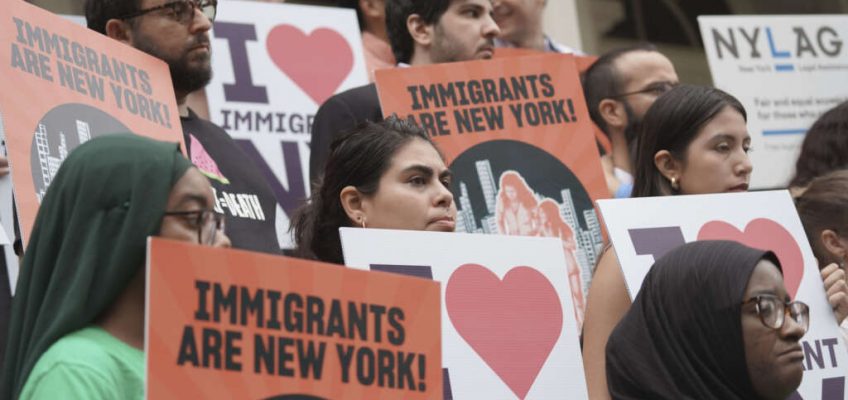The spending plan includes a funding boost for immigration legal services, which one advocate called “an important victory.” Another initiative to launch a new department to regulate e-bikes has sparked concerns about over-policing of the largely immigrant-run food delivery sector.
A City Council rally in late June calling for more funding for immigration legal services in this year’s budget. (Gerardo Romo / NYC Council)
Late last month, Mayor Eric Adams and the City Council unveiled details of the city’s nearly $116 billion budget for the new fiscal year, which kicked off July 1.
Unlike past budget negotiations where the mayor and lawmakers wrangled heavily over budget cuts, this time several programs that will directly impact the city’s immigrant communities got a boost.
This includes extra funding for free legal services—which advocates say is needed now more than ever as the Trump administration pursues mass deportations—as well as for childcare programs open to New Yorkers of any immigration status.
The budget will also fund a new initiative within the Department of Transportation to oversee deliveries, including regulating e-bikes—though advocates say they’re worried it could result in over-policing of the largely immigrant-run food delivery sector.
Here’s a look at what the budget deal included for immigrant New Yorkers.
A boost for legal services
Key initiatives include $74.7 million for immigration legal services.
Of the programs in this category, legal services for low-income immigrants received the biggest funding increase, rising from $4.4 million in fiscal year 2025 to $33.2 million this year, a more than 600 percent bump.
The funding “will ensure continuity of services and help defend immigrants against ongoing aggressive, anti-immigrant policies,” reads the budget summary.
Immigrant advocates cheered the extra funding, which comes as U.S. Immigration and Customs Enforcement (ICE) agents carry out more visible arrests of migrants in city streets and following immigration court hearings.
Murad Awawdeh, the president and CEO of the New York Immigration Coalition, said the budget deal “is an important victory for immigrant and low-income New Yorkers.”
The budget also increased funding for legal counsel for immigrant children in removal proceedings, from $3.9 million in fiscal year 2025 to $16.5 million in fiscal year 2026, a 323 percent hike. This came after several years of advocates pushing for more funding, after the budget item had remained stagnant for over four years.
The money will support legal screenings, representation, and community referrals for unaccompanied minors and families. Since 2022, tens of thousands of asylum seekers and migrants have arrived in the city, fueling an uptick in the number of unaccompanied immigrant youth.
The need for attorneys has increased this year due to federal funding cuts to legal services and increased enforcement by the Trump administration.
Although advocates celebrated the increased, they say it’s still insufficient.
“It doesn’t equate to, every child will get full representation in New York City,” said Sierra Kraft, executive director of the Immigrant Children Advocates Relief Effort coalition, “but it does demonstrate a key leadership and commitment to not leaving vulnerable children without support.”
Kraft added that this is a one-year sum and that legal providers will have to navigate hiring and staffing up as judges fast-track court cases, making it harder for providers to keep pace with demand.
“We’ve seen an increase in immigration judges moving cases forward, even if the unaccompanied child doesn’t have an attorney,” Kraft said. “So we’re trying to carefully monitor how many times, how many appearances that young people have before they’re going to get their removal order.”
Mayor Eric Adams and City Council Speaker Adrienne Adams shaking hands on the this year’s budget deal on June 27, 2025. (Ed Reed/Mayoral Photography Office)
A third initiative that received a substantial boost was the New York Immigrant Family Unity Project (NYFUP), which launched in 2014 to give legal help to immigrants who are in detention centers and may face deportation. Unlike criminal cases, in immigration court, legal counsel is not guaranteed. NYFUP funding increased by 50 percent in this year’s budget, moving from $16.6 million during the last fiscal year to $24.9 million.
Another program that received more funding is the Rapid Response Legal Collaborative (RRLC), which is also supported by the state through its Office for New Americans. This program helps people who are detained or at risk of being detained and deported.
“There was increased investment in Rapid Response work, reflecting what we are seeing on the ground: increased detentions and deportations of individuals and families,” said Jodi Ziesemer, co-director of the immigrant protection unit at New York Legal Assistance Group, one of three legal service providers that are part of RRLC.
“Violating due process norms, this increased immigration enforcement includes people who have U.S. citizen family, may be eligible for immigration relief and who deserve an opportunity to be heard.”
The budget also includes $3 million for grassroots organizations that support survivors of domestic violence in immigrant communities through the Culturally Specific Gender Based Violence Initiative, about which Speaker Adrienne Adams and Council Member Sandra Ung wrote this week.
Child care and body cameras
The 2026 budget includes $10 million to launch a universal childcare pilot to provide free care to hundreds of kids under 2.
A Council spokesperson said that the new program is open to all New Yorkers, regardless of their immigration status (though neither City Hall nor the Mayor’s Office of Immigrant Affairs, or MOIA, responded when asked this question).
The city is also continuing to provide $25 million in funding for early childhood education programs like Promise NYC, which provides childcare for undocumented families who can’t qualify for other programs.
Additionally, the New York City Department of Sanitation (DSNY) police officers in the Vending Enforcement Unit will get body-worn camera equipment. DSNY did not respond to questions about this change.
But the Street Vendor Project, which advocates for local vendors (the majority of whom are immigrants), said they’ve been pushing for DSNY police to wear body cameras since the Sanitation Department took over vending enforcement in 2023.
“As a policing agency, we believe it is important for DSNY (as well as Parks Enforcement Patrol) to have just as stringent oversight as the NYPD and are glad the budget includes this line item,” said Carina Kaufman-Gutierrez, the organization’s deputy director.
“In the future, we would also like to see Parks Enforcement Patrol have body cameras, and the implementation of an external agency similar to the Civilian Complaint Review Board that monitors or addresses complaints against peace officers,” she added.
Food delivery workers, pictured here at a 2022 press conference with City Councilmembers. (John McCarten/NYC Council Media Unit)
Department of Sustainable Delivery
The budget includes $6.1 million for a new “Department of Sustainable Delivery” within the Department of Transportation to regulate commercial e-bikes.
The department is a long-time goal of Mayor Eric Adams. He proposed it in his third State of the City address in January 2024 as “a first-in-the-nation entity that will regulate new forms of delivery transit and ensure their safety.”
Currently, little is known about how the department will run. “There is actually no framework yet for the Department of Sustainable Delivery. It’s included in the budget as a line item that has been proposed by the mayor’s office, but it would require legislative action by the City Council in order to actually be established,” said Council Deputy Press Secretary Mara Davis.
Davis disputed Mayor Adams’ claim that it is the City Council that is not moving forward with legislation to establish the department.
“That’s simply not true. There is no legislation that is currently under consideration by the Council; we’re kind of waiting on them to bring that to the table, and it’s really his concept,” Davis said.
The mayor’s office referred City Limits’ questions about the initiative to a press release it issued Monday.
The announcement said the department “will conduct enforcement against illegal moped, e-bike, and e-scooter riding; hold delivery apps accountable by ensuring that commercial cyclists are using safe and legal equipment and that delivery companies face repercussions for unsafe behavior; and address vehicle parking behaviors that endanger pedestrians, cyclists, and e-bike riders.”
It will do this through 45 “peace officers” tasked with issuing moving violations and enforcing businesses’ compliance with commercial cycling laws, though those officers are not set to be deployed until 2028.
The new department would directly affect the approximately 65,000 deliveristas in the city. Advocates are concerned it will only further criminalize workers and put many at risk of deportation, at a time when the Trump administration is cracking down on immigrants.
Ligia Guallpa, executive director of Workers Justice Project, the non-profit organization that backs Los Deliveristas Unidos, which advocates for delivery workers, says this department is not the solution to protecting them or ensuring street safety.
Guallpa says they worry about the lack of information about the department as well as the approach the administration’s language about it suggests. “Rather than protecting workers, holding multi-billion dollar app corporations accountable, [the approach] has been more towards regulating e-bikes, and with that, regulating deliveristas.”
Guallpa says elected officials should instead focus on regulating app delivery companies and guaranteeing protections to deliveristas. She says unrealistic delivery time requirements create pressure on workers who cannot afford to lose their jobs.
“If they really want deliveristas to prioritize street safety,” said Guallpa, “it starts by giving the legal rights for them to fight back the pressure and the retaliation that they’re dealing with [with] the apps.”
This comes at a time when advocates are already concerned about an NYPD policy change in which officers now write criminal summonses instead of traffic tickets for cyclists. Gualpa says deliveristas are often a main target of such enforcement.
“NYPD and the New York City mayor [have] built a partnership to start criminalizing and creating a pipeline for potential deportation and targeting immigrant workers,” said Gualpa. Instead, WJP wants to see physically protected bike lanes, community-led education about street safety for deliveristas, and charging stations, among other infrastructure changes.
“Let’s create and redesign our streets to adapt it to the new reality of our neighborhoods and our city,” said Gualpa.
To reach the reporters behind this story, contact Daniel@citylimits.org and Victoria@citylimits.org. To reach the editor, contact Jeanmarie@citylimits.org
Want to republish this story? Find City Limits’ reprint policy here.
The post How NYC’s Latest Budget Impacts Immigrant Communities appeared first on City Limits.




